I Want to Design a Art for T Shirt Third Class Crow

1917 recruiting poster for the United States Navy past Howard Chandler Christy, featuring a adult female wearing the most widely recognized uniform, the enlisted clothes dejection.
The uniforms of the Usa Navy include clothes uniforms, daily service uniforms, working uniforms, and uniforms for special situations, which accept varied throughout the history of the navy. For simplicity in this article, officers refers to both deputed officers and warrant officers.
Dress uniforms [edit]
The United States Navy has iii categories of dress uniforms, from least to virtually formal: service, full, and dinner dress.
Service apparel [edit]
Service wearing apparel uniforms are worn for official functions not ascent to the level of full or dinner wearing apparel. They are also commonly worn when traveling in official capacity, or when reporting to a command. The civilian equivalent is a business suit. Service Dress Bluish may be worn year-round, while Service Dress White is reserved for summer or tropical zones. Ribbons are worn over the left breast pocket in all variations of the service apparel compatible. An all-weather overcoat or reefer coat may be worn with service dress uniforms in common cold or choppy weather.
Officers and master little officers [edit]
Service Dress Blue [edit]

An officeholder inspects enlisted sailors in Service Clothes Blue (2008)

A female U.S. Navy officer in Service Apparel Blue compatible (2012)
The Service Dress Blue (SDB) compatible consists of a dark navy blueish accommodate coat and trousers (or optional skirt for women) that are nearly black in color, a white shirt, and a black four-in-hand necktie for men or a neck tab for women. The textile is more often than not wool or a wool blend, depending on the vendor. The men'south jacket is double-breasted with vi gilded-colored buttons, and the women'due south jacket single breasted with a unmarried row of four gold-colored buttons. Rank insignia are golden sleeve stripes for commissioned officers, while rating badges and service stripes are worn on the left sleeve by main petty officers (CPOs). The prescribed headgear is a white combination cap, although a navy blue garrison cap is optional in some situations when the jacket is non worn, unless stated otherwise past the prescribing authorisation. Beginning in 2016, the Navy began phasing out the distinct female person combination cap and now prescribes a cover similar to the male person version for female officers and CPOs; the prior female person versions were authorized for wear until October 2018.[one] Commissioned and warrant officers above form W-2 wear a cap badge of the U.Due south. shield and hawkeye in argent upon gold crossed anchors, warrant officers at course W-ane a pair of crossed anchors, while CPOs wearable a single fouled anchor. The combination embrace'due south chinstrap is gold for deputed and warrant officers, narrower aureate for midshipmen and warrant officers 1, and blackness for CPOs. Females typically wear beltless slacks with the SDB, although since January 2017, belted slacks tin be worn every bit an culling.[2]
Service Dress White [edit]
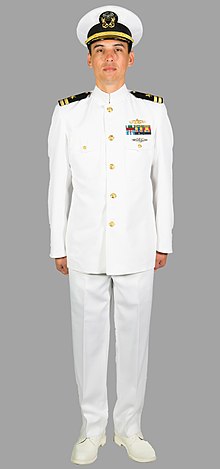
A lieutenant models the Service Dress White compatible (2015)
The Service Dress White uniform had until recently been different for the men's and women'south variations. Men clothing a high stand-collared white tunic, with shoulder boards for officers or metal anchor collar devices for CPOs, white trousers, and white shoes. This compatible is informally called "chokers" due to the standing collar. The textile, formerly cotton wool, today is a weave of polyester known as "Certified Navy Twill". The white combination cap is the prescribed headgear.[3]
Women previously wore a compatible similar to the Service Dress Bluish uniform merely with a white coat and skirt or trousers. Officer's rank insignia consisted of lacing on the sleeves in the same manner as on the blue uniform, while CPOs wore rank insignia pins on the lapels of the jacket. Still, the Navy announced female compatible changes to resemble the men's uniforms, and female officers and CPOs began wearing stand-collared tunics like to the male uniform in early 2017, with total replacement of the sometime-manner compatible by the terminate of Jan 2020 (delayed from an initial date of December 2019).[4]
Junior enlisted sailors [edit]
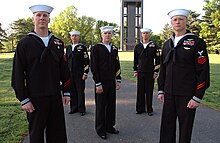
Petty officers in 2006 wearing service dress blue uniforms displaying both cerise and aureate rating badges and service stripes.
Service Dress Dejection for male junior enlisted sailors are based on the classic crewman suit in navy blue, colloquially referred to as "crackerjacks" because of the sailor-suited effigy that adorns the packaging of Cracker Jack snacks. They consist of a navy blueish wool pullover jumper with a tar-flap collar adorned with three rows of white stripes on the collar and cuffs and two white stars, i at each corner of the collar. A blackness silk or synthetic fiber neckerchief, rolled diagonally, is worn effectually the neck, nether the collar, with the ends tied in a foursquare knot in the center of the breast. The trousers for the uniform are flared as "bell bottoms". The trousers take traditionally featured a wide-autumn opening, though changes to the trouser appear in 2012 have added a zippered fly, rendering the buttons but decorative.[5] A traditional white "Dixie cup" chapeau is also worn, equally well as black leather shoes. For a cursory period in the 1970s and early 1980s, male enlisted sailors in paygrades E-one to East-half dozen wore a double-breasted blueish compatible based on the version worn by officers and CPOs, but with grey buttons and a combination encompass with an emblem consisting of a silver eagle and the messages "USN".[half dozen]

The female junior enlisted sailors' Service Dress Blue uniform was formerly similar to the short-lived male uniform from the 1970s.[7] [8] This uniform was phased out and was replaced by a female-cutting variant of the "crackerjacks" with the transition begun in October 2016 and completed by the end of January 2020 (delayed from its initial date of December 2019).[4] [ix] [10]
Until 2016, the junior enlisted Service Dress White uniform, for both sexes, consisted of a white jumper with obviously collar, white bell-bottom trousers with a fly front (or optional skirt for women), black leather shoes, the blackness neckerchief worn in the same manner as with the Service Dress Bluish uniform. Males wore the white "Dixie cup" cap, while females wore the aforementioned cap every bit their Service Clothes Blue uniforms. That Service Wearing apparel White jumper was actually derived from the one-time Undress White, with its broad cuff-less sleeves and no piping. However, beginning in October 2015, Service Dress White jumpers were changed to feature navy blue piping on cuffed sleeves, stars and navy blueish pipage on the collar, and a yoke, making it a 'photo-negative' of the Service Dress Blue jumper.[11]
Ribbons are worn with these uniforms over the elevation left pocket opening, along with qualification or warfare insignia. Either the all-conditions coat or peacoat may be worn with this uniform in cold or inclement weather condition. The color of the enlisted charge per unit insignia and service stripes for the Service Apparel Blues is either reddish or gold based upon how many years the wearer has served (prior to 2019 information technology was contingent on disciplinary history); the colors on the Service Apparel Whites are e'er blackness.
Full apparel [edit]
Full Wearing apparel uniforms are worn for ceremonies such every bit changes of command, retirements, commissionings and decommissionings, funerals, weddings, or when otherwise appropriate. Full Dress is like to Service Apparel except that instead of ribbons, full-size medals are worn to a higher place the left chest pocket, with ribbons worn on the opposite side for decorations without corresponding medals. Swords or cutlasses are authorized for wear by officers and chief petty officers,[12] and may be required for Lt. Commander and above.
For the Ceremonial Guard in Washington, D.C., the junior enlisted Full Dress uniforms are further modified with the wearing of a white pistol belt, ascot, and wearing apparel aiguilette (the latter two are white for winter and navy blue for summer), and white sheet leggings. Other honor guards are only authorized leggings and white pistol chugalug.
-
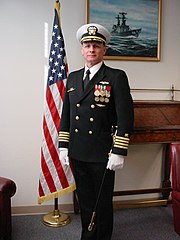
A navy captain's "Total Dress Blue Uniform" with full-sized medals, white gloves and sword (2007)
-
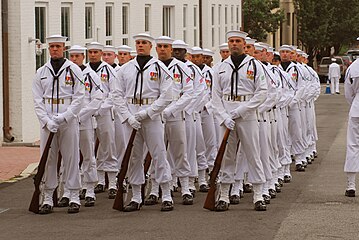
Enlisted Total Dress Whites worn at a Change of Command Anniversary in 2009. This is the older-style version that is due to be replaced in 2021; it lacks the blueish piping and stars
Dinner apparel [edit]

A Navy officer in bluish mess dress (2017)
The dinner apparel uniforms of the United States Navy are the nigh formal and have the nearly variations. For officers, in that location are Dinner Wearing apparel Blue and Dinner Dress White, Dinner Clothes Bluish Jacket and Dinner Dress White Jacket, and Formal Dress. Although trousers are authorized, women frequently clothing the appropriate colour skirt.
Dinner Dress Bluish and White are identical to their Service Dress versions, merely worn with miniature medals and badges with no ribbons. Dinner Dress Bluish is additionally worn with a dress shirt and black bow tie. These variants are ordinarily worn by many junior officers and enlisted personnel as substitutes for the more than formal Dinner Dress Jacket variant which is but prescribable for Lieutenant Commander and to a higher place and optional for Lieutenant and below.
The Dinner Dress Blue/White Jacket uniforms feature a brusque mess jacket with three buttons on either side, worn open with a black bow tie and gold cummerbund (women substitute a neck tab for the bow tie). Male officers show rank stripes on the sleeves of the jacket for the blueish version and on shoulder boards for the white version, while women officers only wear sleeve stripes. This uniform is equivalent to blackness tie in usage.
The Formal Apparel variation is the most formal, and is identical to the Dinner Apparel Blueish Jacket uniform but worn with a white waistcoat with gold buttons in place of the cummerbund, a white bow necktie, and matching mother-of-pearl studs and gage links. Though rarely used, men can likewise substitute a tailcoat for the standard dinner clothes jacket with this uniform. The female version is substantially the same as Dinner Dress Blueish Jacket, just substitutes the female parent-of-pearl studs and cuff links for golden. This compatible is equivalent to white necktie in usage. Additionally, this uniform is only prescribed for chiefs and officers.
Headgear is not required for dinner apparel uniforms unless an outer jacket is worn.
Those property the rank of lieutenant and beneath accept the option of using the Dinner Clothes uniform when Dinner Dress Jacket is prescribed. The enlisted sailors who are chief petty officer and above wear a uniform similar to the officers, just with rank insignia and service stripes on the left sleeve. While enlisted who are petty officer first class and below take optional Dinner Dress Jacket uniforms similar to the officers and chiefs, they may also wear their Dinner Clothes uniform, which is the traditional Service Dress "crewman suit", with miniature medals instead of ribbons.
Service uniforms [edit]
Service uniforms are the U.S. Navy's daily wear uniforms, and exist in several variations. They are intended for utilize in role environments, in positions that interact with the public, and in scout situations. Skirts are authorized for women in all service uniforms.
Officers and chief trivial officers [edit]
Service Khaki [edit]

U.S. Navy chief lilliputian officers wearing the Service Khaki uniforms with the erstwhile female "bucket-styled" combination covers in September 2006.
The Navy first authorized a khaki compatible in 1913 as a practical garment for early naval aviators; they were given permission to wear Marine Corps khaki uniforms with naval insignia when flying or working on aircraft.[13] Khakis were authorized aboard submarines in 1931 and as an officeholder's working compatible on all ships in 1941.
The Service Khaki uniform today is reserved for officers and enlisted sailors at main petty officer and above. It is a short-sleeved khaki button-upwardly shirt and matching trousers, worn with a gold belt buckle. The shirt features two front flap pockets and an open collar. Ribbons are worn above the left pocket of the shirt, with the warfare insignia in a higher place them. A nametag may be worn above the right pocket, and rank insignia is worn on the neckband. The regulations for ribbons state the highest three awards, or all ribbons tin be worn at once. Headgear consists of either a combination cap with a khaki cover or a khaki garrison cap.[fourteen] Currently black and brown oxford shoes are authorized for all officers and CPOs,[15] though traditionally chocolate-brown shoes are worn just by aviators. Females are authorized to vesture the same over-blouse as junior enlisted sailors. The compatible is also worn past buck officers and cadet chief petty officers in the Navy Inferior ROTC.[16]
Summer White Service [edit]
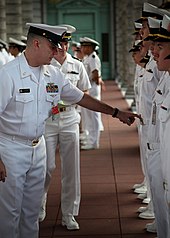
U.S. Naval Academy Midshipman being inspected wearing Summer Whites (2010)
The Summertime White Service uniform (formerly known as Tropical White Long and nicknamed the "milkman" and "Expert Humor" uniform) consists of a brusque-sleeved, open-collared white button-up shirt, white trousers and belt, and white dress shoes. Authorized headwear is the combination cap. Officers vesture shoulder boards with this uniform, while chiefs habiliment metallic neckband insignia. The women's shirt for all ranks has shoulder straps, but conduct goose egg except for shoulder boards worn by officers. Like Service Khakis, Summertime Whites are available in several materials (poly/cotton wool and Certified Navy Twill). When assigned as the Uniform of the Day, a Plan of the Day/Plan of the week will state "Summer White." Either the All-Weather Coat, Blueish jacket, or Peacoat may be worn with this compatible. While one time authorized for inferior enlisted, it is now restricted to officers and chiefs. Members E-6 and below previously wore a short-sleeved Summer White uniform with charge per unit insignia on the left sleeve, but the uniform was discontinued by the Navy in December 2010.
Junior enlisted [edit]

The Navy Service Compatible for inferior enlisted sailors (2008)
[edit]
The U.S. Navy underwent a comprehensive review of every uniform from 2004 through 2007, intending to replace the different working uniform for all hands and the seasonal service uniforms with a single twelvemonth-round service uniform for junior enlisted personnel below main petty officeholder. The Navy Service Compatible has replaced the Winter Blue Uniform and Summer White Uniform (both discussed beneath), which were phased out on 31 December 2010 when the rollout of the new service uniform was completed. Enlisted personnel now have a single Service Compatible. Navy Junior ROTC units likewise received this new uniform, where, unlike in the U.S. Navy proper, it is worn by both cadet officers and enlisted cadets.
The Navy Service Uniform is a year-round service uniform to withstand twenty-four hours-to-day classroom and role-like environments where the service compatible is typically worn. It consists of a brusk-sleeve khaki shirt for males and a khaki weskit-style blouse for females, made from a wash and wear 75% polyester, 25% wool blend, with permanent military creases, blackness trousers for males with beltless slacks for females and optional beltless skirt, and a black unisex garrison cap. Argent anodized-metal rank insignia is worn on shirt/blouse collars and cap. The service compatible also includes a black relaxed-fit jacket with a knit stand-up collar and epaulets, on which niggling officers article of clothing large, silver anodized-metal rate insignia.
Working uniforms [edit]
Working uniforms are described by the navy as being worn when other uniforms may become unduly soiled or are otherwise inappropriate for the task at hand. These are worn at bounding main and in industrial environments aground. In July 2010, the Navy Working Compatible and coveralls became the merely authorized working uniforms. 5-neck sweaters were authorized with coveralls until 2015.[17]
[edit]

A female person officer wearing the NWU Type Iii in AOR-2 (2016)

A digitized rendition of a swatch of AOR-two, the camouflage blueprint used on the NWU Type III.

A digitized rendition of a swatch of AOR-1, the camouflage blueprint used on the NWU Type 2.
The Navy Working Uniform (NWU) is a utility uniform with multiple pockets on the shirt and trousers. Three versions of the compatible be, each with a multi-color digital camouflage print pattern like to those introduced by other services. Type I is predominantly blue with some gray for the majority of sailors. It was originally developed for shipboard use, just proved unsuitable for shipboard environments and was discontinued in 2019. Blazon II is a desert digital pattern currently restricted to SEALs and other sailors such as Seabees assigned to Naval Special Warfare Units when in desert environments. Blazon III is a woodland digital pattern for sailors in shore commands and riverine units. The cover-up patterns are similar to the MARPAT worn on the Marine Corps Combat Utility Uniform by U.Southward. Marines.
The colors of the NWU Type I, co-ordinate to the U.S. Navy, were intended to reverberate the navy's heritage and connection to seaborne operations,[18] while hiding wear and stains, something unavoidable with the utilities and working khakis used previously.[19] The colors were chosen to match the most ordinarily used pigment colors aboard ship, extending the lifetime of the uniform on long deployments where uniforms often come into contact with freshly painted surfaces. An ballast, USS Constitution, and hawkeye (ACE) emblem is embroidered on the left chest pocket on all Blazon I NWUs. Accessories included a navy blueish cotton T-shirt, an eight-point utility comprehend, and a web chugalug with closed buckle. The uniform was worn with rank insignia on both collar points and on the forepart console of the utility embrace, with sew-on name and "U.Due south. NAVY" tapes, also on the new digital background pattern, having aureate-colored lettering for officers, CPOs and midshipmen. All ranks below CPO wore silverish-lettered proper noun tapes. The NWU Type I was phased into service beginning in January 2009.,[twenty] merely was phased out as of ane October 2019.
The Type II and Iii patterns are overall darker than their corresponding MARPAT progenitors, modified with different colour shades and a vertically-aligned pixel blueprint for the woodland version (compared to the horizontal alignment of woodland MARPAT).[21] The additional patterns addressed the fact that the blueish and grey Type I pattern was not meant for a tactical environment.[22] Rank insignia is embroidered and worn on a tab in the heart of the body, proper name and "U.S. Navy" taps are embroidered in brown (Type 2) or black (Type III). Backlash from Marines, including an objection from Commandant Conway, led to restrictions when wear regulations were released in 2010.[23] The Type 2 is restricted for habiliment to Naval Special Warfare personnel, while Type III was restricted to Navy ground units until late 2016.[24] The ACE keepsake is omitted from the NWU Blazon 2 and NWU Type III.
The uniforms are primarily equanimous of a l/50 nylon and cotton blend, which eliminates the need for a "starch and press" appearance and reduces the possibility of snags and tears from abrupt objects (thus making the garment last longer). However this blend combines loftier flammability with the forcefulness to hold onto the crewman's body while burning.[25] [26]
In August 2016 the U.S. Navy announced that information technology is eliminating the NWU Type I in favor of the Type III which was phased in by i Oct 2019 for wear as the standard working uniform aground for all Navy personnel.[27] [28] Type 3 will begin beingness issued to new navy recruits in October 2017. The Type 2 will remain restricted to wear past Naval Special Warfare sailors when in desert environments. The Navy's goal of developing a single working uniform for wearable aboard ship and aground and by all ranks and rates which the NWU Type I was supposed to fulfill was never realized by the Blazon I. Soon after its introduction it was found to be unsuitable for shipboard wear considering of its lack of flame resistance and and then was banned from wear aboard send (except for when in port) thus making it essentially a uniform to be worn while aground only. As a uniform for wearable ashore only, a blueprint designed to muffle stains aboard ships is not well-nigh every bit effective at concealment as a design designed to muffle people on country, thus the IIIs are used aground. The Navy continues to work to develop a new shipboard working uniform.
While Navy uniforms traditionally have featured an indication of rank on the cover, the Type Iii uniforms have been designated to replace the rank insignia with the Anchor, Constitution, and Eagle (ACE) insignia per guidance that "The design of the eight-point utility cap is scheduled for a design change that volition replace the rank device with the ACE logo" [29]
All-atmospheric condition garments include a unisex pullover sweater, a fleece jacket, and a parka, all of which are available in matching camouflage patterns.[thirty] Beginning in 2016 the Navy had planned to likewise upshot a lightweight version of the NWU Type I more than suitable to hot environments.[ane]
Black safety boots, identical to those worn by U.s. Coast Guard personnel with their Operational Dress Uniform, are worn with the NWU Blazon I. Brown or tan boots can be authorized for wear with the Type II and Three, though blackness is the standard color for sailors located in the contiguous United States. Boots come in two versions: black smooth leather boots, and black suede no-polish boots for optional wear while assigned to non-shipboard commands.
Shipboard Working Compatible [edit]

A navy seaman wearing flame-resistant "FRV" coveralls in 2015.

A navy quartermaster in 2014 wearing poly/cotton coveralls. The poly/cotton coveralls have largely been replaced by the flame-resistant variant, though it is still authorized for wear past the navy.
The U.S. Navy issued a new model coverall for apply as a shipboard working compatible starting time in early on 2014. The new flame resistant variant (FRV) coverall is used aboard all ships. It has largely replaced for shipboard employ polyester cotton fiber blend coveralls that provided inadequate burn down protection and the NWU Blazon I for the same reason. The all cotton wool FRVs are dark blue in colour compared to the older coveralls, which are lighter.[31] [32] They utilize rectangular velcro-backed nametags similar to those worn on flight crew suits, rather than the nametapes of the previous coverall.
U.S. Fleet Forces Command (FFC) continues a multi-stage clothing exam of improved flame resistant variant (IFRV) working uniform components for shipboard wear. FFC most recently conducted in-depth focus groups with fleet sailors aimed at refining the blueprint of the IFRV coverall.[33] The IFRV coverall was approved for issue on 17 January 2017. Boosted feedback from the focus groups, subsequently validated by a senior level working group, resulted in the preliminary blueprint of a more professional looking ii-piece utility shipboard uniform that tin exist worn both at bounding main and operational support jobs ashore. Vesture tests of the paradigm two-piece variants are expected to occur in 2017.[34] [35]
Coats [edit]
All enlisted sailors may clothing the navy blue pea glaze, with a rate insignia on the left sleeve for petty officer third grade and higher, a navy blueish "All Atmospheric condition Glaze" with rate insignia worn on the collar, or a navy blue Working Compatible Jacket with charge per unit insignia worn on the neckband.
Officers and main petty officers may wear the calf-length wool "bridge glaze" or waist-length reefer, with gold buttons and rank insignia worn on the shoulder boards, or the all-weather glaze, with rank insignia likewise worn on the shoulder or neckband, depending on rank.
All sailors are authorized to article of clothing the "Eisenhower" jacket with short-sleeved service uniforms with appropriate rank devices on the shoulder boards. The "Eisenhower" jacket is a waist length, black jacket with knit cuffs, and is named for its clan with Dwight D. Eisenhower. The khaki windbreaker, previously authorized simply with the service khaki compatible, was discontinued on xxx September 2016.
Naval aviators, naval flying officers, naval flight surgeons, naval aviation physiologists, and naval aircrewmen are authorized to wear K-i seal-brown goatskin-leather flight jackets, with warfare insignia listed on a name-tag (rank optional) over the left breast pocket, either permanently stitched to the leather or attached with a Velcro hook-and-loop fastener. These jackets were previously adorned with various "mission patches," which betoken places the wearer has served. Today, patches on the G-1 are limited to a maximum of three in improver to the proper noun-tag, i.due east., a unit of measurement insignia on the correct chest pocket, an aircraft type insignia on the right sleeve and an shipping type insignia or embroidered U.Due south. flag on the left sleeve.
Also, the Navy issues foul-weather or cold-weather jackets equally appropriate for the surround, which are generally olive or Navy blue in color. These jackets are considered "Organizational Article of clothing". They do not belong to the sailor, and are not immune for wear off of the send unless working in the near vicinity of a ship.
Special compatible situations [edit]
[edit]
All enlisted members of the U.S. Navy Band, Washington, D.C. and the U.Due south. Naval Academy Band, regardless of rate, clothing chief petty officer-way dress uniforms (i.e. Service and Full Wearing apparel Blues and Whites and Dinner Dress).[36]
[edit]

Corpsman wearing the Marine Corps Service Compatible in 2007.
As the Marine Corps does not have medical personnel, chaplains, and certain lawyers and divers, the Navy provides them.[a] These officers and enlisted of the Armada Marine Forcefulness include doctors, dentists, nurses, hospital corpsmen, medical service sailors, chaplains, religious program specialists, Naval Gunfire Liaison Officers, divers, lawyers, legalmen, and Naval Academy midshipmen who are selected for marine officership. Because of this relationship, these personnel are authorized to wear U.Due south. Marine Corps utility (desert/woodland) uniforms with Navy rank insignia replacing the Marine insignia for enlisted personnel (Navy and Marine officer rank insignia are identical) and with a "U.S. Navy" patch replacing the "U.S. Marines" one. They wear the viii-point utility cover, only it lacks the Marine Corps emblem. Additionally, Navy personnel attached to Marine units can elect to habiliment Marine service uniforms, with Navy insignia. Those opting to wear Marine Corps service uniforms must meet Marine Corps grooming and concrete appearance standards, which are more stringent than Navy standards. This does not apply to the MARPAT uniforms, as this compatible is required for wear in the field when attached to Marine units, regardless of adherence to Marine Corps grooming standards. Navy personnel are not authorized to wear the Marine Corps Dress Bluish Uniform; instead Navy Clothes Blue and White uniforms are worn.[37]
Other wear of combat utilities [edit]

Navy Rank and Markings on Army ACU
In addition to Marine Corps detachments, combat utilities are also worn by Navy SEAL teams, along with SWCC crews who acquit clandestine maritime operations including supporting SEAL platoons and SOF cells. The Combat Utility Uniform (CUU) is authorized for those in the Explosive Ordnance Disposal (EOD) and Fleet Diver communities. Gainsay utilities are also authorized for those attached to the Naval Construction Force (NCF) (Seabee), Navy's Expeditionary Logistics Group, or the Navy's Expeditionary Combat Command (NECC). Also, Navy personnel assigned to some joint headquarters units, like Primal Control in Qatar and Republic of iraq, wear Desert Utility Uniforms (DUU). Navy personnel such as Private Augmentees, Combat Photographic camera Groups, Detainee OPS, and some in the special warfare community take been wearing the Ground forces'south ACU (Regular army Combat Compatible) when working closely with or fastened to Army commands.[38]
[edit]
Aviators, Naval Flight Officers, and Naval Aircrewmen are authorized to wearable green or desert flight suits (made of nomex for fire protection), with rank insignia for officers stitched on the shoulders, and a proper name tag/warfare insignia on the left breast pocket. Either a Command/Navy ballcap or a Khaki Garrison Cap (for Deputed Officers and CPOs) are worn with this uniform. Green flight suits are the standard wear; however, wing commanders may authorize desert flight suits for personnel located in hot climates. Equally of 2012, flight suits may now be worn off base of operations in the same fashion as the Navy Working Compatible.
Coveralls are authorized to exist worn with either the all-conditions glaze or utility jacket (for petty officers only).
Flying deck [edit]
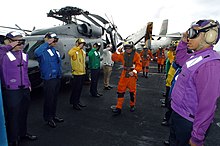
Flightdeck personnel on board an aircraft carrier wearing different colored jerseys, cogent a specific role. (U.S. Navy) (2004)
Flight deck crew wear colored jerseys which distinguish each personnel'south function by sight.[39]
| Color | Job |
|---|---|
| Yellowish |
|
| Green |
|
| Ruby-red |
|
| Purple |
|
| Bluish |
|
| Dark-brown |
|
| White |
|
USS Constitution [edit]

Officers and crew of USS Constitution (2005)
The send USSConstitution is the oldest commissioned ship in the U.S. Navy, the only one of the six original United States frigates still in existence. Constitution is presented to the public as the send appeared during the War of 1812, and personnel stationed aboard Constitution all the same wear uniforms co-ordinate to regulations posted in 1813. These uniforms are worn on ceremonial occasions, such equally the annual plough-effectually prowl in Boston every Independence Day.[43]
[edit]
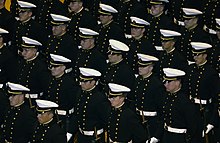
USNA Midshipmen in parade dress (2003)
Naval Academy midshipmen, in addition to standard Navy officeholder uniforms, also wear parade dress of traditional 19th-century armed services cut, waist-length tunics with stand collars and double rows of golden buttons.[44]
Prisoners [edit]
Prisoners in the custody of Navy shore correctional facilities are required to habiliment a special uniform, instead of their regular working uniform. All prisoners, regardless of their military branch clothing the aforementioned compatible, with a dark blue variant for pre-trial confinement and a khaki ane for post-trial confinement.[45]
Obsolete uniforms [edit]
NWU Type I [edit]

A male navy officer wearing the NWU Type I (2008); the compatible was retired in 2019.
Introduced in 2008, the Navy Working Uniform in blue and gray pixelated camouflage was simply in service until 2019, having already been banned from shipboard employ when it was found not to be flame-retardant. It had been subject to mockery both inside and outside the Navy, as "Aquaflage" and "Battle Apparel Oceanic," and pointed questions about the utility of camouflage for ships' crews.[46] The tan and green Type Two and 3 remain in service, for Navy personnel ashore.
Aviation Working Khaki [edit]
Navy Uniform Regulations Alter No. eleven issued 22 June 1917 authorized naval aviators to vesture a summer service flying uniform of Marine Corps khaki of the aforementioned blueprint every bit the officers' service dress white uniform tunic and trousers. Information technology was to be worn with high, laced tan leather shoes only "when on immediate and agile duty with aircraft", and might exist worn nether similarly colored moleskin or khaki canvas coveralls as a "working dress" compatible.[47]
Naval aviators typically flew patrol bombers from shore bases until the first United States aircraft carrier USSLangley was commissioned on xx March 1922. Differing uniforms adrift precipitated a xiii October 1922 Bureau of Navigation letter of the alphabet: "Uniforms for aviation will be the aforementioned every bit for other naval officers, doing away with the dark-green and khaki, which may be worn until June 1, 1923, simply only at air stations." Khaki aviation uniforms of a somewhat different pattern were reinstated on 8 April 1925.[47]
Service Apparel Khaki [edit]

Two naval officers showcase the now-discontinued service wearing apparel khaki uniform in September 2007.
During World State of war Two, a single-breasted heavy cotton twill jacket with shoulder boards was worn with cotton twill trousers over a long-sleeved cotton shirt with a black necktie as "Service Clothes Khaki", allowing cleaning in shipboard laundry facilities. Later on, through the Vietnam War, the trousers and jacket were often made of low-cal wool or wool-alloy textile equally routine access to dry out-cleaning facilities became available. The uniform was dropped in 1975 by then-Chief of Naval Operations, Admiral James Holloway, in order to reduce the number of items in the officer's seabag. A revived version of the uniform was announced in 2006 on a test footing. In 2008 it was authorized for wear by commissioned officers and CPOs during the summer months and in tropical climates.[48] The uniform reintroduced a khaki service glaze worn with a black necktie and shoulder boards. It was intended to provide a more practical alternative to the Service Dress Whites and a more formal alternative to the Service Khakis. This uniform was oftentimes worn in public by Adm. Mike Mullen during his fourth dimension as Chief of Naval Operations and Chairman of the Joint Chiefs of Staff; Mullen was seen wearing this uniform with the jacket removed in the photograph in the White House State of affairs Room during the Navy SEAL raid on Osama bin Laden'due south compound. In October 2012, cost considerations led to the counterfoil of the full-scale reintroduction of the uniform, and the compatible was dropped from the Navy.[49] [fifty]
Service Dress Blueish Yankee [edit]

U.S. Navy Uniform: Service wearing apparel blue Yankee, male Navy officers, 1983.
The rarely seen Service Dress Blue Yankee uniform replaced the dark trousers and black shoes of Service Clothes Bluish with white trousers and shoes from the white uniform. Prescribed for officers.[51]
Winter Blue [edit]
The Winter Bluish uniform was authorized for all ranks. Due to its well-nigh-blackness color, it was chosen the "Johnny Greenbacks" uniform (a reference to the song/album Man in Black past the singer of the aforementioned name).[52] [53] It was a long sleeve black button-upwardly shirt and black belt and trousers (optional brim for females), with the headgear either the combination embrace (all E-vii and in a higher place, female person E-6s and below) or white Dixie Cup (male E-6s and beneath). Garrison caps were an optional secondary headgear, allowed to be worn for all ranks.[54] [55]
As a service compatible, ribbons and badges were worn, and officers and main petty officers wore metal collar insignia, while enlisted East-6 and below wore simply the rating badge on the left arm. All men wore ties, females necktabs, with an optional silverish clip for sailors at the charge per unit of petty officer first class and below, others a gold prune. The Working Bluish variant omitted the tie and ribbons.
Working Khaki [edit]
The Working Khaki uniform was worn by officers and master footling officers, primarily aboard transport or in selected working areas at bases ashore. Originally information technology was just the Service Clothes Khaki uniform worn without the coat and necktie. Like to, only less formal than, the Service Khaki, it consisted of a short or long-sleeve khaki uniform shirt, with warfare insignia and badges (i.east. command pins, nametags, etc., only no ribbons) worn on the summit of the left pocket, and pin-on metallic rank devices located on the neckband. It also came with a set up of khaki trousers, a khaki belt with a gilt belt buckle, a control or "U.S. Navy" ballcap (garrison cap optional), and black or brownish low quarter shoes, black or dark-brown boots, or blackness leather rubber shoes. Information technology was oft referred to every bit the "Wash Khaki" uniform, considering it was a 100% cotton uniform that could be laundered simply required pressing, differentiating it from the Service Khaki made of Certified Navy Twill (CNT) or a poly-wool alloy that is considered adequate for article of clothing ashore and off base of operations, but which requires dry out-cleaning. At the showtime of January 2011, the working khakis were replaced past the Navy Working Uniform, although the Navy Junior ROTC still uses them as of 2017.[xvi]
Aviation Working Green [edit]
A wintertime working green uniform for commissioned officers and Chief Petty Officers in the Naval Aviation community was authorized on 7 September 1917 in conjunction with adoption of the naval aviator wings breast insignia. The initial compatible design was the same every bit the officers' service dress white uniform tunic and trousers. Similar the summertime khaki uniform, it was to be worn with high, laced tan leather shoes. Like the aviation khaki uniform, the green compatible was temporarily banished during the early years of United States aircraft carrier operations from 1922 until a modified blueprint was reauthorized in 1925.[56] The final version, discontinued in January 2011, was somewhat like to the Navy's revived Service Clothes Khaki compatible in cut and design and bore boosted similarities to the Marine Corps' Service Dress "Alpha" light-green uniform. It consisted of a green wool coat and light-green wool trousers with bronze buttons and a long-sleeve khaki shirt with black tie. Rank insignia consisted of blackness embroidery on sleeves in a style like to the golden sleeve complect for officers, or rating marks and service "hash" marks for Chief Petty Officers, on Service Clothes Blueish uniforms. Metal rank insignia was worn concurrently on the neckband points of the khaki shirt by line officers and CPOs. For staff corps officers, rank insignia was worn on the right collar point and staff corps insignia on the left collar point (typically Medical Corps for Naval Flight Surgeons, etc.) of the shirt. Warfare insignia and, if applicative, Command at Sea and/or Command Ashore insignia, were worn on the jacket and optionally on the shirt. Command nametags were also optional on both the blouse and/or shirt. Brown shoes were typically worn, although this transitioned to blackness between 1975 and 1986 when brown shoes were discontinued. Following the reinstatement of brown shoes in 1986, brown shoes again became the most common footwear. Authorized headgear included a combination cover in green, or a light-green garrison embrace.
During World War II and the Korean War, ribbons were too authorized with this compatible, making it a de facto "service uniform" or "liberty uniform," authorized for wear off base of operations. But by the early 1960s, it had go limited to that of a "working uniform" for use on base of operations or aboard transport just. It was infrequently worn, primarily due its expense and its 100% wool cloth that typically made it unsuitable outside of the winter months; in the working environments where AWGs were authorized, aviators typically found working khakis or flying suits more user-friendly.
The AWG uniform was formally phased out on 1 January 2011 along with several other uniforms as function of an extensive U.S. Navy uniform consolidation. The Type I Navy Working Uniform took its place.[57]
Tropical Uniforms [edit]
The rarely seen Tropical White Uniform (likewise referred to equally Tropical White Short) was similar to the Summer White Service uniform, except white knee shorts and knee joint socks were worn. Information technology was colloquially known as the "Captain Steubing" uniform, after the character on The Love Gunkhole Goggle box show. Uncommonly rarely worn, though authorized with this uniform, was a pith helmet, with a Naval Officer's insignia at the front end, to a higher place the brim.
Tropical working uniforms existed, but were variations on the working khaki and utility uniforms. Knee shorts and blackness articulatio genus socks are worn, along with short sleeved button-up shirts.
Summer White/Blue ("Table salt and Pepper") [edit]
Initially worn by Eastward-vi and beneath beginning in the mid-1970s with the temporary phaseout (until 1982) of the traditional "crackerjack" uniforms, it was later expanded to include chief little officers and commissioned officers. Best known by the nickname "salt and peppers," the uniform consisted of a summertime white shirt and winter blueish (e.g. black) trousers for males and summer white blouse and winter bluish trousers or wintertime blue skirt for females. The uniform was worn with a combination cover and black shoes. Although naval personnel still retained all the components that fabricated up this compatible, its apply was discontinued in 1983. Though the U.Southward. Navy proper discontinued the uniform in 1983, Navy Junior ROTC units continued to habiliment information technology for decades subsequently, until they themselves finally discontinued their usage in June 2010.[58] [59]
Service Dress Gray [edit]
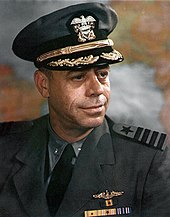
Helm Allan McCann wearing the Service Wearing apparel Gray uniform (1944)
This brusk-lived uniform for officers and CPOs was only authorized from 1943–49, but was a common sight on the East Declension and in the Atlantic/European Theater during Globe State of war Ii. It was identical in cut and textile to the Service Wearing apparel Khaki uniform simply medium gray in color with black buttons, worn with a lighter gray shirt and garrison or combination encompass. Officers' shoulder boards were also gray, with stars/corps insignia and rank stripes in blackness. "Working grays" were the same uniform worn without the jacket and tie. The grayness uniform was introduced by and then-Chief of Naval Operations Ernest King, who thought khaki was more than advisable to land forces; Admiral Chester W. Nimitz disliked information technology and discouraged its article of clothing in the Pacific Fleet.
CPO Whites [edit]
From 1893 until 1975, chief petty officers wore a Service Dress White uniform consisting of white cotton trousers and double-breasted reefer jacket with blackness necktie. Rating badges and service stripes in black were worn on the left sleeve. This uniform was likewise worn by members of Navy bands regardless of rank. Officer-design whites were authorized for CPOs in 1981.
Dungarees [edit]

Freed U.S. POWs in Globe State of war 2-era dungarees (1945)
Dungarees were the junior enlisted (E1-E6) working uniform worn from 1913 through the 1990s; through World War II dungarees with a garrison or combination embrace were likewise worn by CPOs engaged in muddied jobs. Unlike later working uniforms, dungarees were not immune to be worn outside of military installations; service members were allowed to wear the uniform to and from the installation in a vehicle, but were not authorized to brand any stops between while in the dungarees. In fact, until World War 2 dungarees could only exist worn in port in ships' interior spaces, below the main deck or inside gun turrets.[ citation needed ]
Dungarees consisted of a short or long-sleeve bluish chambray shirt, white T-shirt, and bong-bottom denim jeans (the jeans in question had heptagonal "patch" pockets sewn on the forepart of the pant-legs rather than the traditional "slash" pockets oft seen on civilian-worn jeans). Headgear was the white "dixie cup" cover for men and an early form of the blackness garrison cap or a black beret for women; after graduation from boot camp, the command ball cap was optional (and in practice more than common). Starting in 1995, the white hat was no longer authorized for wear with dungarees, and the command (or Navy) ballcap became the predominant cover. During common cold weather a black scout cap was allowed.
The sailor'southward last proper name was stenciled in white on the pants but above the back pocket on the right side. The name was also placed in blackness on the shirt just higher up the right chest pocket, usually stenciled on. Names could also be reinforced with embroidered thread of the advisable color on both the pants and shirt. Charge per unit badges (for petty officers) and warfare devices were iron-on. The rate badges consisted of an all-black eagle (nicknamed a "crow") and chevrons, omitted the rating device plant on other enlisted uniforms' rate badges.
Low black leather boots called "boondockers" were issued with the dungaree uniform; however, sailors were immune to vesture black leather jump boots. Flying deck personnel were issued a type of taller cap-toe boot similar in blueprint to bound boots known colloquially equally "wing walkers". These types of boots had zig-zag patterned out-soles to avoid gathering FOD (Foreign Object Debris) betwixt the ridges that could litter the flying deck and cause potential damage to aircraft. "Dealer/Chelsea" style ankle boots (known colloquially as Lox boots) with rubberband-sides were issued to personnel working with Liquid oxygen for easier removal in case the boots would freeze upon contact.
Utilities [edit]

A navy corpsman in 1999 wearing the "dungaree" compatible
The enlisted utilities uniform was worn by junior enlisted sailors, from paygrades E-one to E-6, from the 1990s until 2010, when they were phased out in favor of the NWU. Utilities consisted of dark blue chino cloth trousers with a polyester–cotton blend shirt, and were considered an updated version of the dungarees uniform of which they shared an aesthetic similarity. Utilities were meant to exist worn in a working environment just were authorized to be worn outside military installations, unlike coveralls.
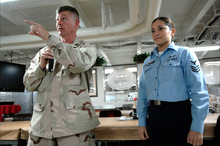
A navy crewman wearing the "utility" compatible in 2009
Normally sailors wore the command brawl cap with this uniform, although a black watch cap was allowed in cold weather; the white "dixie cup" lid was worn for special ceremonies such as the dignified transfer of a decedent. Cloth name tapes were worn similar to that used on utility uniforms of the other services. In 1995 a tape with the words "U.S. NAVY" began being included higher up the left breast pocket with embroidered enlisted warfare insignia authorized to a higher place information technology, and an embroidered rating badge. The footwear for this uniform was full blackness, circular-toed boots (referred to equally boondockers), preferably with steel toes. The blue utility jacket was authorized in climates not common cold enough as to warrant wearing the black All-Weather condition Glaze.
Enlisted Undress Blues [edit]
Prior to the introduction of the Winter Blue/Winter Working Blue uniform, personnel E-6 and beneath in office and classroom environments were authorized to wear the Undress Blue compatible; this broadly resembled the Dress Blue "crackerjack" compatible simply carried no pipage or stars, and the sleeves were wide and cuffless like those of the current Dress Whites. Before 1941 this was the standard working uniform for all "above-deck" duties since dungarees were not permitted anywhere the public might meet them. Ribbons and neckerchief were non worn and the uniform was not authorized for liberty.
Enlisted Apparel Whites (prewar) [edit]
Until 1941, the summer and tropical equivalent to the Dress Blue "crackerjacks" was a white cotton jumper uniform with blue tar flap and cuffs, adorned with white piping and stars like the blue compatible. This uniform was discontinued "for the duration" and was never reinstated; instead the Undress Whites with the addition of ribbons and neckerchief became the summertime dress uniform for sailors.
The "Flat Chapeau" [edit]

U.South. Navy sailor James R. Ward wearing the Apartment Lid (1940 or 1941)
From 1852 until 1962 (although in practice rarely worn after the eye of World War Ii), enlisted sailors were issued a round, flat blue wool sailor hat with a ribbon effectually the ring like to that worn by the Royal Navy. The "Donald Duck" was worn with the Service Clothes Blue compatible on more formal occasions in lieu of the white "Dixie cup." The ribbon carried the name of the wearer'south ship or station embroidered in gold until 1941, when this was replaced with a generic "U.Southward. Navy" equally a wartime security measure.
See also [edit]
- Badges of the United States Navy
- United States Navy officer rank insignia
- Listing of United states Navy staff corps (insignia)
- Listing of United States Navy ratings
- U.s. Navy enlisted rate insignia
- Listing of camouflage patterns#North America N-Z
- Uniforms of the United States Military
- Uniforms of the U.s.a. Marine Corps
Notes [edit]
- ^ The Chief of Naval Operations and Commandant of the Marine Corps are heads of separate branches – the connections between the Navy and Marines include that they report to the Secretary of the Navy and they share common legal institutions like Naval Criminal Investigative Service and the Navy-Marine Corps Court of Criminal Appeals.
References [edit]
- ^ Burke, R.P. (January 2017). "NAVADMIN 015/17". United States Navy. Retrieved 3 April 2017.
Effective immediately and until further notice, optional wear of male person E7 and in a higher place SDB trousers is authorized with the female SDB uniform. The manner of wear of male trousers is per electric current uniform policy.
- ^ "UNIFORM COMPONENTS". NAVY PERSONNEL COMMAND. US Navy. Retrieved xv April 2020.
- ^ a b Navy Uniform Matters Office (Baronial 2019). "Summer Uniform Wear and News" (PDF). UNIFORM NEWSGRAM. Arlington, Virginia: Navy Uniform Matters Function. p. 3. Archived from the original (PDF) on fourteen Baronial 2019. Retrieved 14 August 2019.
- ^ Naval Personnel Public Diplomacy (18 May 2012). "Navy Announces New Uniform Components, Regulations". Department of the Navy.
- ^ "Archived re-create". www.history.navy.mil. Archived from the original on 22 Feb 2005. Retrieved 12 January 2022.
{{cite web}}: CS1 maint: archived copy as title (link) - ^ Office of the Principal of Naval Operations (31 July 1972). "Women'due south New Apparel Blues Aren't Blueish". OPNAV Information Bulletin. Notes of Interest. Washington, D.C. 20350: Navy Department. Retrieved 23 Nov 2015.
{{cite web}}: CS1 maint: location (link) - ^ Worthington, Rogers (5 July 1986). "Saluting A Return To Navy Tradition: To Rebellion And Back In A Decade". Chicago Tribune. Illinois. Retrieved 23 November 2015.
- ^ Main of Naval Personnel Public Affairs Office (ix October 2015). "Navy Announces Rollout and Article of clothing Dates for Upcoming Uniform Changes". All Hands. The states Department of the Navy. Retrieved 23 November 2015.
- ^ Navy Personnel Command (March 2014). "@USNPeople Uniform Newsgram" (PDF). Navy Uniform Matters Office. United States Section of the Navy. Archived from the original (PDF) on half dozen February 2015. Retrieved 6 February 2015.
- ^ "White and blueish crackerjacks moving forward". Navy Times. twenty Apr 2015.
- ^ "History of US Navy Uniforms (1776-1981)". The Navy Department Library. 15 June 2006. Archived from the original on three July 2006. Retrieved iii July 2006.
{{cite spider web}}: CS1 maint: bot: original URL condition unknown (link) - ^ Us Navy Uniform Regulations NAVPERS 15665. Accessed 10 February 2015.
- ^ a b "A field manual for the Navy Junior Reserve Officers Training Corps (NJROTC)". January 2017. Archived from the original on 21 August 2019. Retrieved 25 November 2019.
- ^ "Archived copy" (PDF). world wide web.public.navy.mil. Archived from the original (PDF) on eighteen August 2018. Retrieved 12 January 2022.
{{cite spider web}}: CS1 maint: archived copy every bit title (link) - ^ "Military machine Photos: The New Navy Work Uniform". Strategy Page. StrategyWorld. 4 May 2006. Retrieved 19 October 2009.
The colour pattern of the NWU (navy blue, deck grayness, haze grayness and blackness)
- ^ "Navy Compatible Oftentimes Asked Questions". New-Navy-Compatible.com. Archived from the original on 10 May 2010. Retrieved 19 October 2009.
- ^ Faram, Mark D (30 Oct 2008). "Blue cammies coming soon". Ground forces Times Publishing Company. Archived from the original on 5 Nov 2009. Retrieved 5 November 2009.
- ^ McCullough, Amy (xx January 2010). "Your thoughts: Navy may attempt Corps-like camo". Marine Corps Times. Archived from the original on 12 June 2010. Retrieved half dozen May 2010.
- ^ "Navy Working Uniform (NWU) Concepts Oft Asked Questions". Chore Forcefulness Uniform Public Affairs. The states Navy. 13 January 2005. Archived from the original on xviii January 2005. Retrieved 6 May 2010.
- ^ "NAVADMIN 374/09: Navy Working Compatible Type 2 and 3". Primary of Naval Operations. CDR Salamander. 4 January 2010. Retrieved 6 May 2010.
- ^ "Sailor Outcry over Desert Camo Denial". Navy Times staff. Marine Corps Times. 22 February 2010.
- ^ "Why Is the Marine Corps Fighting With the Navy Over a Camouflage Pattern?". The Atlantic. 17 Jan 2013. Retrieved 4 October 2014.
- ^ "NWU nether fire: Report raises concerns". Retrieved 4 October 2014.
- ^ "Navy Announces Elimination of NWU Type I". 5 August 2016. Archived from the original on five August 2016.
- ^ "The U.Southward. war machine is dumping the dumbest uniform ever". 5 August 2016. Archived from the original on 5 August 2016.
- ^ "NAVADMIN 17214". Retrieved 12 June 2018.
- ^ Foutch, Michael (two March 2006). "New Navy Working Compatible and Service Compatible Concepts Canonical". Navy News Staff. Retrieved v Nov 2009.
- ^ US Fleet Forces Public Affairs. "Flame-Resistant Coveralls Coming to the Fleet Presently". United states Fleet Forces Command.
- ^ "Navy uniform policy: 14 changes start now". Navy Times. 7 September 2015.
- ^ "USS Carney Tests Improved Flame-Resistant Variant Coveralls". seven August 2016. Archived from the original on seven August 2016.
- ^ "USNSCC Homeport" (PDF). USNSCC Homeport.
- ^ "US Navy to Test Two-Piece, Flame-Resistant Organizational Habiliment". soldiersystems.net. v March 2019. Retrieved 21 August 2020.
- ^ "Department 3: U.S. Navy Bands". Special Compatible Situations. 5720 Integrity Drive, Millington, Tennessee: Navy Personnel Command. 26 February 2018. Retrieved 7 June 2020.
Enlisted members shall conform to the designation and composition of uniforms prescribed for chief niggling officers, Chapter 3, Department 3, with the exception of service khaki uniform.
{{cite spider web}}: CS1 maint: location (link) - ^ "Chapter ii – Training Standards", U.S. Navy Uniform Regulations, United States Navy, archived from the original on xiii April 2009
- ^ "Archived copy". www.public.navy.mil. Archived from the original on 17 May 2014.
{{cite web}}: CS1 maint: archived copy as title (link) - ^ "Rainbow Wardrobe". U.S. Navy Part of Information. Retrieved 16 May 2007.
- ^ John Pike (vi April 2000). "Carrier Design". Globalsecurity.org. Retrieved 13 October 2015.
- ^ "Rainbow wardrobe". Official Website of the United States Navy. Retrieved 26 April 2020.
- ^ Chivers, C.J. (25 January 2012), "Potent Sting Is Prepared in the Abdomen of a Warship", The New York Times, nyt.com, retrieved 26 January 2012,
A version of this commodity appeared in impress on January 26, 2012, on folio A6 of the New York edition with the headline: Strong Sting Is Prepared In the Belly Of a Warship.
- ^ "Captain and Crew". Naval History. Archived from the original on i May 2013.
- ^ "Infantry Dress". US Naval Academy. Retrieved 3 January 2020.
- ^ "Navy Corrections to Mandate New Uniforms". US Navy. 24 April 2019. Archived from the original on 27 April 2019. Retrieved 27 April 2019.
- ^ Faram, Marking (22 Baronial 2017). "The U.S. military is dumping the dumbest compatible ever". Navy Times.
- ^ a b Van Wyen, Adrian O. (1969). Naval Aviation in World War I. Washington, D.C.: Principal of Naval Operations. pp. 9& 74.
- ^ Courtney Kube (17 July 2008). "New Navy compatible goes retro". MSNBC Digital Network. Archived from the original on 21 July 2008.
- ^ "Navy Announces Service Dress Khaki Counterfoil". Armed services.com. 23 October 2012. Retrieved 10 December 2012.
- ^ "NAVADMIN 314/12". 19 Oct 2012. Retrieved 31 March 2017.
- ^ Service Wearing apparel Blue Yankee for male person Archived 23 April 2009 at the Wayback Machine (archived version) and for female (archived version) officers
- ^ Faram, Mark D (28 March 2005). "New duds for everyone?". Navy Times. Army Times Publishing Company. Retrieved 16 October 2009.
They include service khakis, clearly the virtually used of the trio; summer whites, featuring white pants and shirts and shoulder boards for officers; and the less-visible winter dejection, commonly known as the "Johnny Cash" uniform.
[ permanent dead link ] - ^ Van Avery, Chris (4 Oct 2004). "The practiced, bad and ugly of proposed uniforms". Navy Times. Army Times Publishing Company. Retrieved 16 Oct 2009.
Combining a curt- or long-sleeved white shirt with the blueish trousers already in sailors' seabags eliminates the trouble of keeping summertime white trousers white and Johnny Cash shirts unburned by a temperamental iron.
- ^ "U.Southward. Navy Uniform Regulations, Male person Enlisted Winter Blueish Compatible". half-dozen October 2006. Archived from the original on 6 Oct 2006.
{{cite web}}: CS1 maint: bot: original URL condition unknown (link) - ^ "U.S. Navy Uniform Regulations, Female person Enlisted Winter Blue Uniform". twenty May 2007. Archived from the original on 20 May 2007.
{{cite web}}: CS1 maint: bot: original URL status unknown (link) - ^ Van Wyen, Adrian O. (1969). Naval Aviation in Globe War I. Washington, D.C.: Chief of Naval Operations. pp. 33& 74.
- ^ "On This Date in Naval Aviation History: Aviation Greens Make A Comeback". Naval History Blog. viii April 2010. Archived from the original on 12 April 2010. Retrieved 12 April 2010.
- ^ Navy Junior ROTC Cadet Field Manual (PDF) (8th ed.). Naval Education and Grooming Control. June 2010. Archived from the original on 31 March 2017. Retrieved 31 March 2017.
{{cite book}}: CS1 maint: bot: original URL status unknown (link) - ^ Navy Junior ROTC Cadet Field Transmission (6th ed.). Naval Pedagogy and Training Command. Baronial 2005. Archived from the original on 25 December 2018. Retrieved 28 December 2018.
Further reading [edit]
- U.S. Navy Uniform Regulations (November 2020)
- U.S. Navy Compatible Regulations, Summary of Changes (March 2017)
- Navy Clothing & Textile Update Presented to Joint Accelerate Planning Brief for Industry (October 2015)
- U.S. Navy uniform regulations, 2006
- United States Navy Uniform Regulations (January 1998)
External links [edit]
- Official website
Source: https://en.wikipedia.org/wiki/Uniforms_of_the_United_States_Navy
0 Response to "I Want to Design a Art for T Shirt Third Class Crow"
Post a Comment